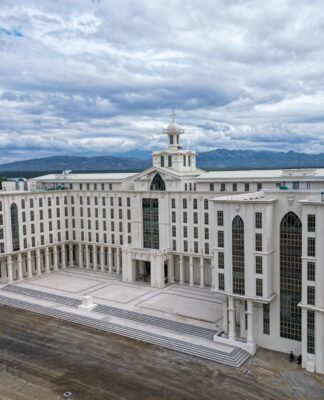
RESEARCH from the Philippine Institute of Volcanology and Seismology (PHIVOLCS) showed an impending “big one”–an earthquake of at least 7.2 magnitude from the West Valley Fault that could devastate Metro Manila.
Renato Solidum, Ph.D., the director of PHIVOLCS, said about 31,000 deaths, 14,000 to 385,000 injured, and at least P2.6 million of economic losses are at stake should the earthquake hit an unprepared Metro Manila.
“We are not saying that the next earthquake from the fault will be [magnitude] 7.2,” Solidum said. “We are saying that the fault is capable of releasing an earthquake of that strength.”
The West Valley Fault is a locked fault located along the Marikina Valley. It was discovered by geologists in the 1920s while PHIVOLCS learned it was active during the 1990s.
According to the United States Geological Survey (USGS), faults are breaks found on the Earth’s crust. Locked faults, which do not move for long periods of time, could gather more energy and generate very powerful earthquake compared to other faults.
Earthquakes may occur when tectonic plates between these faults move. Solidum cited the Marikina Valley as an example, with the West Valley Fault slowly stretching the central part of Luzon for thousands of years, eventually forming the valley.
“During the 90s, PHIVOLCS and the USGS released a report that the [West Valley] fault moved four times in the past 1,400 years. The movement has generated close to magnitude seven earthquakes,” he said. “While the interval between those events was not exact, they have an average interval of 400 to 600 years.”
Solidum said that the last earthquake from the fault occurred in 1658 or 356 years ago. Though earthquakes do not follow patterns, he said this might be an indication of a future calamitous event that needs preparation.
“If you compare 356 to 400, then it’s almost like [the earthquake will occur] within our generation, or maybe in the next [generation],” he said.
7.2 magnitude
PHIVOLCS currently monitors two fault lines, the West Valley Fault and the Manila Trench, due to their potential to release very powerful earthquakes.
PHIVOLCS estimated the maximum magnitude of an earthquake that could occur along the West Valley Fault to be 7.2.
Solidum, on the other hand, said that an earthquake from the Manila Trench could reach as high as magnitude 8.3 and even generate a tsunami.
Aside from ground shaking, other hazards to expect are fires, landslides and liquefaction. A tsunami may also occur if the fault is located near a body of water.
Liquefaction is an event where soft layers of sand may behave like liquid during ground shaking. Solidum said this could cause buildings to tilt and fissures to occur on roads.
“Though liquefaction is not considered a killer event, [it] will affect the mobility of people because of the damage it could cause,” he said, adding that Manila is part of the areas in the region with high liquefaction potential.
Should liquefaction happen alongside ground shaking, fires and landslides, Solidum warned that people may be isolated inside Metro Manila.PHIVOLCS, in a recent study, created a vulnerability map after considering the earthquake’s potential damage to nearby cities and provinces. There are four “isolated zones” located along the map, one for each cardinal direction.
These zones could be “isolated” should liquefaction and other earthquake hazards impair or even destroy roads, bridges and other modes of transportation connecting cities in Metro Manila that are along rivers.
If the Pasig River becomes impassable, cities like Quezon City and Makati could be isolated to the north and to the south zones, respectively. On the other hand, should the Marikina River be impassable, cities like Manila and Pasig could be separated to the west and to the east zones, respectively.
Solidum added that relief and search and rescue response could be designed with the “isolation zones” in mind. Due to the characteristics of each zone, respondents should be mindful of the resources each zone might require.
For example, Manila, which is located along the west zone, is almost directly beside the Manila Bay. Should the 7.2 magnitude earthquake happen, Solidum will expect help for Manila to come from the Manila Bay via sea transport, or from places outside the isolation zones.
He added that fixing modes of transportation along these zones should be prioritized.
“You cannot just visit places right after an earthquake,” he said. “This is why you have to fix roads and make sure bridges are passable after the event.”
Structurally safe
Meanwhile, University officials assured that buildings inside the campus are strong enough to withstand a 7.2 magnitude earthquake.
Lawrence Pangan, the University’s Buildings and Grounds superintendent, explained that structures inside UST were built with an earthquake as strong as magnitude 8.0 in mind. Should the magnitude 7.2 earthquake hit Metro Manila, superficial damages are to be expected but the buildings itself would not give in to the earthquake.
He added that in-house inspections by experts and out-house inspections by visiting officials of municipalities contribute to the management of the University’s structures. Done during the first quarter of every year, these tests are conducted to check what kind of fortification could be done to the University’s structures.
Officials who recently conducted inspections in the University declared that the buildings within the campus are structurally safe. In order to further reinforce the structures better, Pangan said they added piles–materials to improve the foundation of buildings–and retrofitting, or the addition of new technology to improve already-existing structures.


















Did I miss the part where UST was supposed to be gearing up? SOS
Is it P2.6 Million or P2.6 Billion of economic losses?